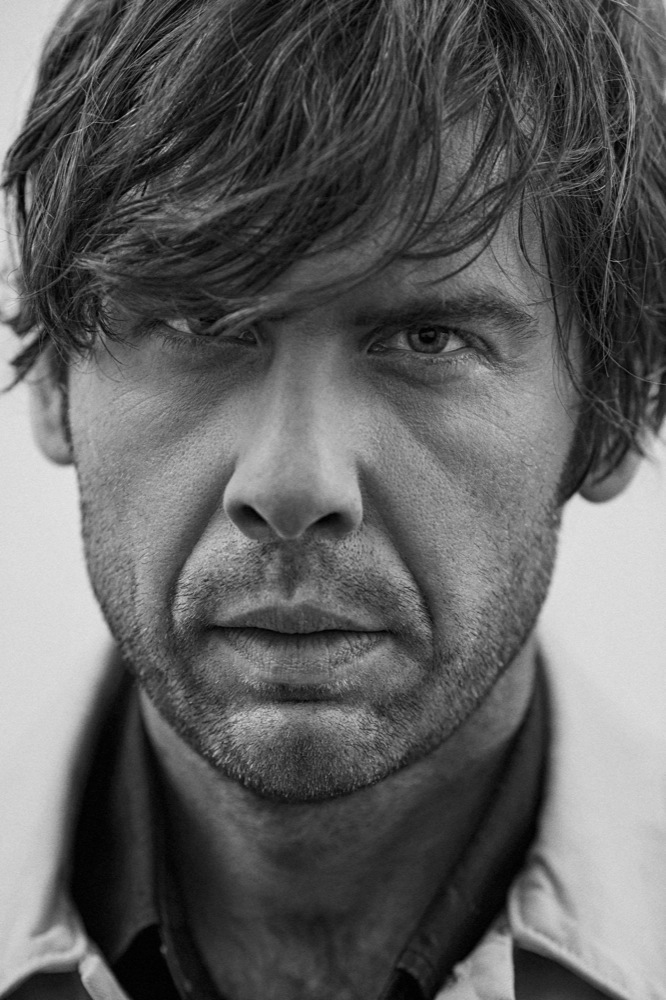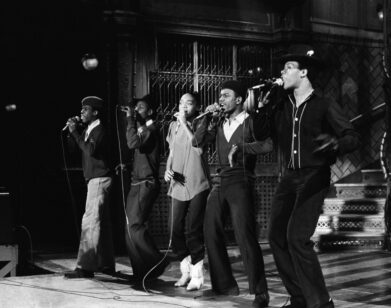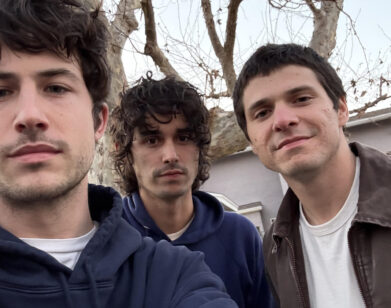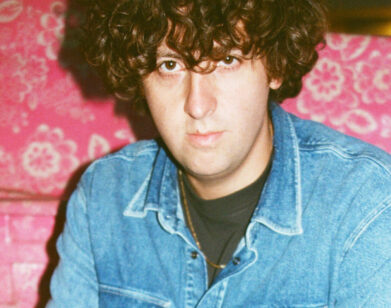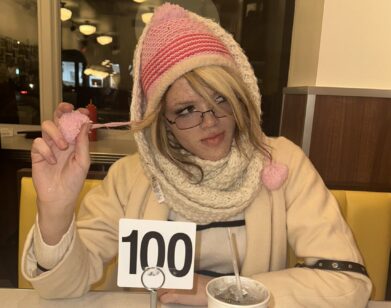Peter Bjorn and John, Beyond the Breaking Point
PETER BJORN AND JOHN IN NEW YORK, MAY 2016. PHOTOS: ANTHONY BLASKO. STYLING: NINA STERGHIOU/BRIDGE ARTISTS. GROOMING: LAURA DE LEON USING ORIBE HAIR CARE AT JOE MANAGEMENT.
Over the past five years Swedish pop/rock trio Peter Bjorn and John seemed to sit in Stockholm in a self-induced silence. While it’s true that they returned to their hometown after releasing and touring their rock-leaning LP Gimme Some in 2011, silence certainly doesn’t describe their state of being, nor does sitting; the three musicians have been toiling away at new music as a group, while individually writing and producing with other artists, including Chrissie Hynde, Franz Ferdinand, and Lykke Li. In 2012, the three also formed the artist collective and record label INGRID alongside fellow musicians (such as Andrew Wyatt and Pontus Winnberg of Miike Snow) and on Friday, that very label will release Peter Bjorn and John’s seventh album, Breakin’ Point.
It took the majority of the last five years for the eponymous members of the band—Peter Morén, Björn Yttling, and John Eriksson—to be satisfied with the music they were creating. Although Ytlling says INGRID Studios has “a great Fleetwood Mac drum room vibe” (it was built in 1970s), the album didn’t proceed smoothly. Morén, Yttling, and Eriksson completed six songs with producer Patrik Berger before the situation devolved.
“We were looking for people who knew both the rock side and the production making song side,” Yttling says of starting with Berger. “It was going well until we started arguing about everything. We finished some of the songs, but we couldn’t really hold [Berger] hostage for more than three months,” he continues. “We thought, ‘Maybe we can finish this on our own and record in the studio,’ but then it just felt like, ‘We can’t really finish this on our own; we have to reach out.'”
In search of producers, they connected with Paul Epworth (Paul McCartney, U2) as well as Greg Kurstin (Sia, Adele) before ultimately working with six outside producers to finish the album. The resultant collection of pop tracks is both playful and melancholic.
Last month the band began touring Breakin’ Point and they will continue to play shows across North America, Australia, and Europe throughout the summer. When we spoke with Yttling over the phone last week ahead of their Stockholm show, he assured us that a certain whistling tune would make their set list, telling us, “We’re definitely going to play ‘Young Folks.'”
HALEY WEISS: You wrote a lot of material after touring Gimme Some that you threw out. What made you trash that material and start fresh with this album?
BJÖRN YTTLING: We started fresh with this album and as you said, we threw out songs because they didn’t measure up. We figured if we go into a rehearsal space and play guitar, bass, and drums, we’re going to sound the same special way that we always [have] because we know that so well. We’ve been playing together for what, 17 years? It’s sort of like, “Let’s get the songs done before we go into that situation,” and by done we meant melodies and lyrics, not leaving it open-ended in that sense. It always changes a little bit, but we wanted to get a proper song before getting into recording mode. We sold our rehearsal space [before forming INGRID] and burned the drum kits, got rid of the guitars, and then we just had acoustic guitars and a piano in a room with nothing else, no TV.
WEISS: Do you all contribute to every portion of the songwriting process or do you each take on portions and come together after the fact?
YTTLING: We came in with demos of our own; that’s how we did the previous couple albums, too. But this time we were more truly [together] because in the past it would have been like, “Well, let’s get that lyric down later,” and someone had to do that but now it was more like, “Do we have this lyric? Is it the best we can get it? How are the vocals fitting with that? What are the chords doing here?” We all write lyrics, we all write melodies, and we all contribute to the chord progressions, so it’s more that we’ve been doing it together in a room this time.
WEISS: Having spent a longer time between records than you had in the past, did you feel pressure to follow up Gimme Some with something particularly different?
YTTLING: We wanted to push it. Gimme Some was a great rock album but we had maybe one hit song on that—it was called “Second Chance”—and this time we wanted to up the whole [album]. On Gimme Some we thought, “Let’s say something cool and play guitar heavy crowd rock music for five minutes,” and that was not what we were aiming for with this album. We wanted to make efficient songs that would be living a life without us playing them too; if people want to cover them it would make sense. Some songs that we did before, only we can do, I think. So these would be more global, evergreen songs that would probably stand the test of time, too—if they have a well thought out form and structure. That’s of course good if you want to make singles and communicate with people and reach people, and make hits. I think we have at least seven or eight “Second Chance”-style hit songs on this one.
WEISS: Excuse the wordplay, but was there a breaking point for all of you creatively speaking when making Breakin’ Point?
YTTLING: I think the breaking point was when Patrik [Berger] couldn’t take it any more. [laughs] No, but he had to go see his family because we kept him in the studio, in a box. We thought, “Either we go for it and find the best possible situation for these songs or we can fold, let it be what it is, and sound all right.” It got a bit dark around that time within the group because we had different [opinions] on how to do that stuff but we decided mutually to go not “the only way is up” but to make the biggest effort you can ever make. It’s like if you go on a hike and you regret it, you can go back, or you can just do it anyway. We decided to go the full marathon. If you step off of that, it’s not fun; you’re not like, “Oh, yeah, I ran half of the New York Marathon.” That’s not so cool. So then we said, “Let’s get some people in here to help us out.” That was the point when something happened and it flipped over.
WEISS: You founded INGRID, the artist collective and label, in 2012. How did it come about?
YTTLING: When we came back from Gimme Some—we were touring—it felt quite funky. It was like, “We’re back, and no one has been in this space since we took off.” It’s the same dust and all of the same things so we thought we could share a studio, and we talked to the Miike Snow guys, Lykke Li, and [others], and realized if we do things together it’s more fun. We found this space that we turned into [a studio]. We didn’t know what we were doing, we just thought, “Maybe we can hang out here more.” We have a sound in Sweden, like Robyn and the guys that are involved in this studio; I think if we take two steps back and look at it we also have an aesthetic sense that we share. [We thought] maybe we can exploit that a little bit, and since we already are doing it, we could put a label on it, a name, and that name was INGRID.
WEISS: Within INGRID you each work on your own projects and with other artists. Is that important to you, to make songs as individuals and with others outside of Peter Bjorn and John?
YTTLING: It’s hard for us to say because we always did that. Maybe it would be better if we didn’t, but it seems impossible for us to not make music all of the time. It also seems impossible to make music within the Peter Bjorn and John bubble all of the time. Maybe since we’ve been a band for 17 years it’s good.
WEISS: The album artwork for the recent singles and the LP includes bent nails, a glove with a dismembered finger, and a hammer. What made you choose those images to pair with this music?
YTTLING: It was the idea of going to the factory like Tamla [Records, which became] Motown; they went in and they worked a lot on their songs. If they weren’t happy, they redid it and would go in early in the morning and come out late at night. It’s a craft when you do pop music but then everybody of course is playing that down in interviews saying, “Oh yeah, that song just flew to me and landed in my hand,” or, “I dreamt it up in my sleep.” It’s sort of cool to not work for it but we think it’s cool to work for it. We’re more into Michael Jackson having three studios, 24/7, for three years, and giving it all and trying to find the greatest songs. That’s what’s really cool. If you just stumble upon a hit song, I don’t know, it doesn’t just happen like that—you have to work for it. It can come fast but maybe you did 200 of them and then one came fast.
WEISS: When you were putting the album together, what other music were you listening to?
YTTLING: We listen to a lot of music, old references and things that we find inspiring, but at that time we also listened a little bit to what was going on in the charts. If you attempt to make current pop music you need to know what’s going on. Pop music is like milk; you can’t keep it too long, it’s going to get smelly.
WEISS: What did you find in the pop music on the charts that you incorporated into the album? Or what did you find most interesting about what you heard?
YTTLING: When we started this album, there was no guitar whatsoever on the charts. You had to look for a guitar with a magnifying glass like, “Oh, yeah, there’s a guitar maybe in the back.” We always use guitars. Then as the years went by there were many more guitars and more acoustic stuff; there’s a much more interesting dynamic feel of songs out there now in the most popular songs that people listen to. It was more like EDM taking over the world when we started the album, so I don’t think we would ever have gone into that situation, but it feels nice now when it’s a bit mellower.
WEISS: What were the older song or band references that you were listening to?
YTTLING: One of the first bands that recorded in the studio we got for INGRID was ABBA before they were named ABBA; they recorded Swedish stuff in there, so that’s cool and we got interested in that broader [sound, with] more instruments on the songs. We talk about them and we also talk about, of course, Michael Jackson, just because of how he crafted every song and how great those songs are. Two people I listened to a lot at that time were The Weeknd and Drake. Things that you can find inspiration in don’t have to sound like what you’re doing really, but you can find angles on it.
We listened to some cheesy stuff that people wouldn’t think is cool, like Roger Whittaker and Mike Oldfield, because you think, “How did they get this song to connect?” It sounds so bad but the melody is so great and you listen to that. That’s interesting sometimes—how the song can prevail without the full production.
BREAKIN’ POINT WILL BE RELEASED THIS FRIDAY, JUNE 10 VIA INGRID. FOR MORE ON PETER BJORN AND JOHN, VISIT THE BAND’S WEBSITE.

